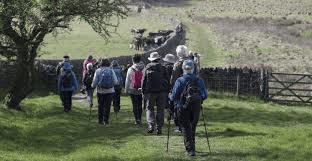Planning a walking route can be done in a number of different ways but one of the best and safest is to use Walking Maps of your chosen area. You can find great maps from https://www.themapshop.co.uk/Explorer_Walking_Maps.htm

The easiest routes, such as National Trails marked with green diamonds, follow waymarked trails. On OS maps, green dotted lines display trails with travel rights, while black dotted lines show trails that may or may not be a right of way.
In England and Wales, except in selected areas such as National Parks, you are usually limited to walking strictly on the right of way. In Scotland, under the freedom to roam Act, you are permitted to walk almost anywhere.
If this can help you link two footpaths together don’t be afraid to at least plot some of the route on the quieter ‘B’ and ‘C’ class roads (shown in orange and yellow). Some of these are quiet and the surface of the tarmac helps you to have a nice level stoll.
On the map, draw or plot your path. You will get a running total of the distance when you plan the path if you are using online maps or map apps, but you will need to use a ruler or piece of string to measure the length if you are using a paper map.

Note that there will be a significantly longer gap on the field than on the map. By planning your route to follow the road, you can get a reasonably precise idea of length, but there will still be a margin for error where you have to detour round mud or find a secure crossing for a stream.
You might want to make sure that you include varied terrain whenever possible when planning routes. If you can combine woodland, inland and coastal / waterway paths, it makes the routes interesting. Keep an eye out for the point maker on the map if you are looking for a good view.